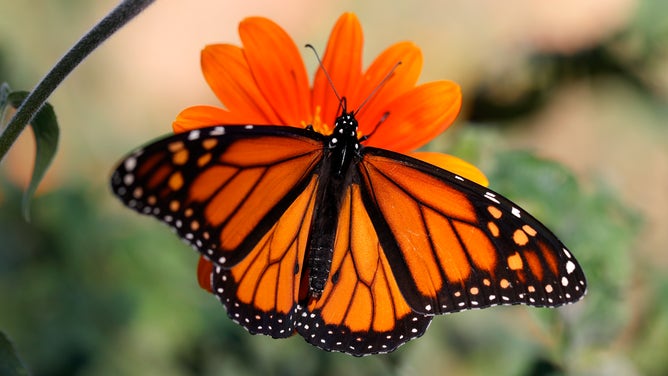
Observers so far counted 50,000 wintering butterflies after counting only 2,000 last year. Scientists speculate why.
The monarchs are back again in force to winter along the California coast. After a dismal showing the past three years, scientists and naturalists weren’t sure they were ever coming back.
“That’s what everybody was so worried about last year when our overall population dipped to under two thousand,” said Stephanie Turcotte Edenholm, an official observer.
“It’s over 30 years that they’ve been counting and keeping track of the populations. The fact that it dipped so low, and it dipped so low for the last three years, there was a great concern,” said Turcotte Edenholm.
“Last year it was under 2,000 and this year they’re already estimating that we have 50,000,” she was relieved to report.
Volunteers like Turcotte Edenholm are trained by the Xerces Society to conduct the official annual western monarch count for three weeks in November and another three weeks around the first of the year.
The western monarchs spend the breeding season, March to October, on the wing, consuming flower nectar and mating west of the Rockies. Migrating butterflies return to the California coast when the weather gets cold. The species return to the same site, sometimes even the same tree year after year.
Turcotte Edenholm explained that forests along the California coast offer winter flower nectar for food. The temperatures are warm enough, so the butterflies won’t freeze but cool enough to allow them to stay largely inactive.
“When it’s 55 degrees their bodies are paralyzed, so they just hang in the trees,” making a count possible in the mornings. The insects congregate in groups to stay warm.
Western monarch butterflies west of the Rocky Mountains migrate to the California coast for winter. Eastern monarchs migrate to Mexico.
Dr. Arthur Shapiro, Professor of Evolution and Ecology at the University of California, Davis says there are about 10 core wintering sites in California. He says he doesn’t know what happened to the western monarchs over the past three years.
“So, as of now we literally don’t know where those 50,000 bugs came from,” says Shapiro who has been tracking butterfly populations since the 60s.
Northern California butterfly counts during the breeding season were unprecedented, “Numbers in the I-80 corridor were extremely low, with no breeding observed and not a single adult seen at our permanent Sierran sites — first time ever for that”.
The I-80 corridor runs from San Francisco to Sacramento past Lake Tahoe in the Sierra Nevada Mountains.
Is drought a possible cause?
Shapiro refutes claims that drought caused the decline pointing to a correlation, “What I can say is that Monarch populations had been in long, slow decline before the 5-year drought and rebounded significantly during the drought.”
Shapiro continued. “They then collapsed catastrophically when the drought ended and have apparently rebounded this year, a year of extreme drought.”
California is in the second year of drought. The previous two droughts for the state 2007-2009 and 2012-2016.
Insecticides may be part of the decline.
Shapiro suspects neonicotinoid insecticides may have had a role in the decline. Pesticide use is lower in drought years because many farmers leave their land fallow. “If pesticides are a cause, I won’t say THE cause, of the declines, this would provide a mechanism to account for improved numbers in dry years,” he adds.
Neonicotinoid pesticides accumulate in the nectar and pollen of treated crops and turf. The E.U. banned several neonicotinoid insecticides, used on crops and turf in 2013 to protect pollinators like bees.
Western monarch populations have been in decline for decades.
The Xerces Society, a non-profit focused on invertebrate conservation, reported a 99% wintering western monarch decline since the 1990s in the Golden State.
A recent study points to warmer autumns.
Shapiro was also cited in a recent study in the Journal Science. The study’s abstract states, “We found a 1.6% annual reduction in the number of individual butterflies observed over the past four decades, associated in particular with warming during fall months.”
But the study also notes that the butterfly populations increase with warning summers.
Why the rise and decline of the monarch merits more research:
“The Monarch is a ‘poster child’ for conservation,” said Shapiro of the orange and black butterflies that frequent summer and spring gardens. Who doesn’t remember studying Monarch butterflies, as kids even witnessing metamorphosis in the classroom?
They merit study said Shapiro, because the western monarchs, “… may reflect much broader trends in the eco-health of the planet. One can’t monitor everything. In fact, one can only monitor a few things, given the cost in time, person-hours, etc. So the desire is to focus on easily-monitored species that we think are likely to reflect processes operating beyond the individual species level!”
(Fox News).